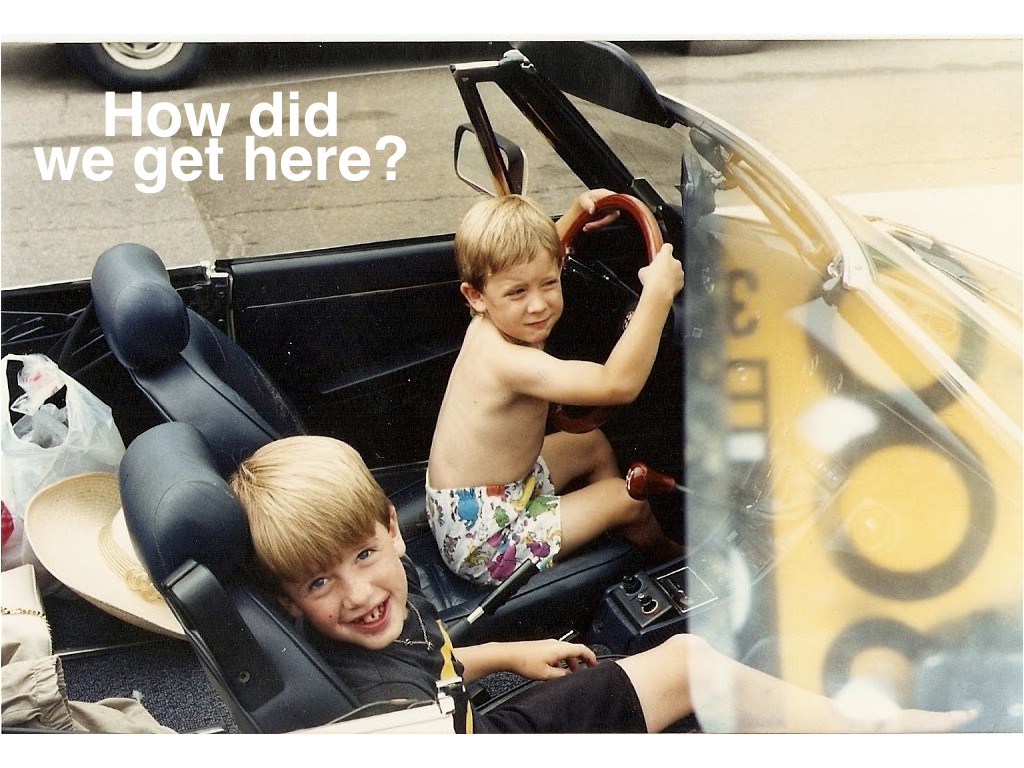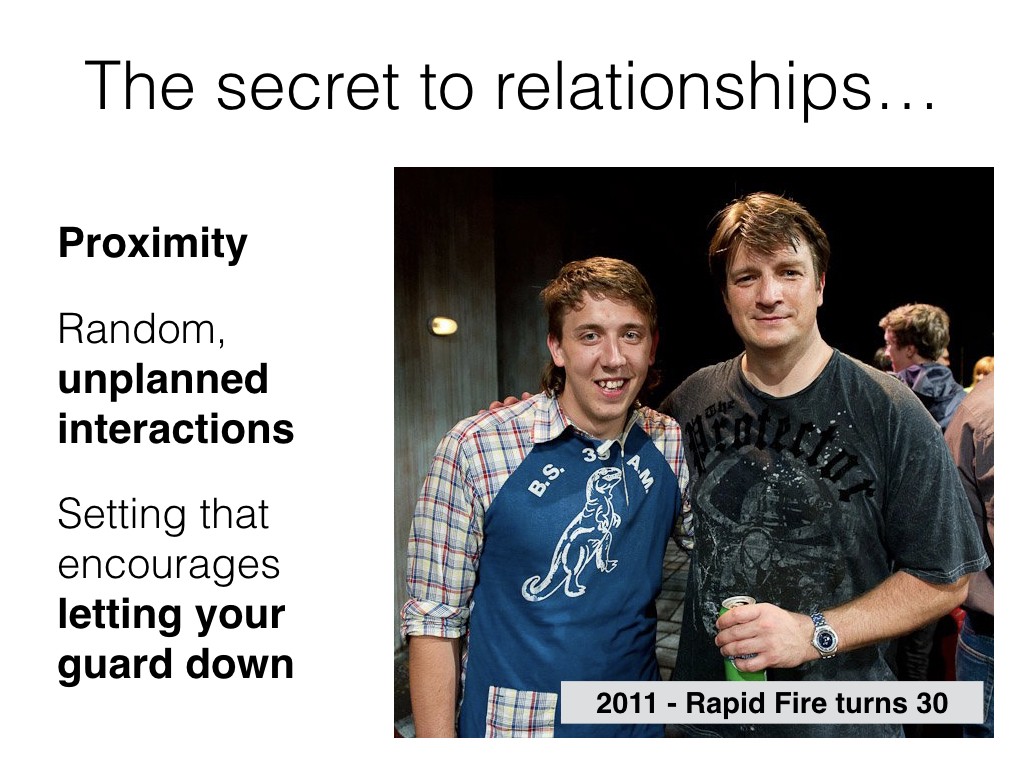Leadership in Improvisation
Recently I was invited to give a talk on Leadership in Improvisation for the Peter Lougheed Leadership College at the University of Alberta breakfast event about Making Connections.

Note: It was critical to discuss the preparation of the talk with a sample of individuals who would be in the audience the week before, this allowed me to understand who would be in the room, what their expectations would be like, and what has worked well, and not as well, for that group in the past.
My name is Kory Mathewson; I am an improviser with Rapid Fire Theatre, and I am also a Ph.D. student in Computing Science studying artificial intelligence and machine learning at the University of Alberta.
If you want to read Part 1 of the story of me making an Artificial Improvisor, check it out here: korymathewson.com/building-an-artificial-improvisor/
Note: it was a failure. A not a total failure, because I learned a lot.
I had four short and clear goals for the morning:
- Teach the history of improvisation and its growing relevance in leadership.
- Share my stories of success and failure.
- Distil everything I have learned over 12 years of improvisation to 6 gemstones takeaways.
- Explore some improvisational exercises with the audience.
The same question my mom asked when she found my brother (9) and I (6) driving in a convertible we didn’t own. Let’s start with a brief history of my improvisation that should help you understand me and how we got to this point?
February 2005 at the Rapid Fire Theatre Nosebowl High School Improv Tournament. A bright-eyed memory of myself performing impeccable mime in cargo shorts, a popped collar pink polo shirt and rolled up tennis socks, with three of my best friends supporting from the bench. We lost that tournament, by a mile but we gained memories and fashion sense.
Flash forward to this month, on stage at Rapid Fire Theatre. Performing alongside the incredibly talented cast and the Mayor of Edmonton His Worship Don Iveson.
Who here knows what improvisation is? Has anyone done improvisation? Has anyone seen a comedic improvisation show? Or performed jazz? Has anyone built an ingenious solution to a problem facing scarce resources and limited time?
Improvisation, much like my life, is art and science. It sits at the intersection between the rules and pure creativity.
By the end of this talk, I promised, you will all be familiar with improvisation and the ways that the principles of improvisation can help guide your leadership and collaboration. First, it is not about being funny, it is about failing together?
I earned my stripes improvising in long 50-hour marathons. These grueling time tests stretch physical and mental abilities and provide an incomparable safe playground of practice.
Practice makes perfect; but why? Because it elucidates your patterns, obstacles and growth goals, then focuses your efforts on improvements.
The more you can adapt, response, and extemporize the more effective you will be. Veterans of the form respond proactively to sudden changes and road blocks.
The first lesson I learned in improvisation is that “the best improv performers can improvise with anyone.” They make everyone else shine; this is not necessarily true about painters, musicians, mathematicians, or lawyers, but it is right about improvisors, and more importantly: leaders.
Once I was in, I was hooked. So I did what any newly committed student of an art form does, I dug deep into the history of improvisation.
The river ran deep. Documented improvisation starts in Rome in the 4th century BC with the Atellan Farce and mask work. Flash forward thousands of years and we learn about Commedia dell-Art(e) in the early 1600’s exploring character archetypes.
Contemporaries in the field have written, studied, tested, tried and failed at shaping the art form. Each with their form of proselytizing:
- Stanislavski: The greatest wisdom is to realize one’s lack of it.
- Spolin 1963: Through spontaneity, we are reformed into ourselves.
- Boal 1973: Theatre is a form of knowledge; it should and can also be a means of transforming society. Theatre can help us build our future, rather than just waiting for it.
- Johnstone 1987: If you have a good idea, open your mouth and say something else.
And of course, no discussion of improvisation would be complete without mentioned the tortured genius of the 20th century, Del Close. A coach and mentor of many of today’s most popular comedians including Tina Fey, Amy Poehler.
With many words of wisdom, one that resonates with me as a leader is:
“Don’t bring a cathedral into a scene, bring a brick and let’s build together.” - Del Close
Bringing us to the first gemstone takeaway.
- Listen
- Actually, listen.
- Most people listen just enough to be able to respond.
- Be willing to change.
- Listen like this is the last thing they ever say.
- Listen to the other is going to change your mind.
“Listen. Listen to one another like you know you are scholars. Artists. Scientists. Athletes. Musicians. Like you know you will be the ones to shape this world.” - Sarah Kay
- Positivity.
- Accept, agree, say “Yes”.
- Accept and offer, say “Yes, and…” - it improves your relationships with others AND with yourself.
- It is also a base principle of meditation. Accept your currently emotional state. Yes I am feeling like this. If this is true, what else is true.
A series of yeses takes us somewhere. All it takes is one no to stop the momentum. But what do we get when we can say: “Yes, and…”
But wait, there’s more…
- Practice saying “Yes, and..”
- Use it to refocus, redirect, and collect thoughts.
- Improvisational leaders accept quickly and look for opportunities immediately.
- Make your agreement prominent.
Much like building a cathedral, we can try collaborating in real time.
You can try as well, with a partner try telling a story by writing it down on a piece of paper one-line-at-a-time, for an additional challenge try writing the story one-word-at-a-time.
Then read the stories back, and see what it is like to directly collaborate on a creative piece. Remember: there are no wrong answers, no mistakes, and no judgment.
You are walking alone in a wooded forest, you have been without food and water for a few days and you are cold, scared and hungry. You come to a clearning and in the middle of the open area there is a saber-tooth tiger… you are afraid. You feel fear. Scientists think this stems from the amygdala, two almond-shaped bundles of nuclei in the temporal lobes of the brain. What is your emotional response?
Most would say fight or flight, there is also new research on the freeze mechanism, and of course, the fourth and least favorable option in real-life, fail. You have to do something very critical in this moment, which leads us to the next gemstone.
- Make choices.
- In improv we often call them offers.
- Make offers instead of asking questions.
- Make your choices specific, unique and novel for bonus points.
Often times when we are forced with a decision we encounter a psychological phenomenon called: analysis paralysis.
Remember that you do not need to be 100% right 100% of the time. In fact, you need to be 100% right only about 10% of the time, the other times you just need to make a decision.
Your choices should be made in an attempt to make others look good. Shelve the ego and embrace the collective elevation and amplification. Endow others with power, status, and agency to create a team that functions better than individuals working independently.
I have tried on 1000 masks and understand the world slightly differently from each perspective.
Alex Williams of the New York Times has a very nice piece on friendships as we progress through life. One of the more salient points to me is that the three elements required for making close friends.
These are the exact characteristics of my interactions with improvisers all over the world. From Liverpool to Austin, to Slovenia, to New York, and back through North America… I have found my community around the world. We build relationships over space and time because we can quickly adapt, work together, collaborate openly and communicate effectively.
My research is in Reinforcement Learning. Training artificially intelligent systems to act in certain ways given rewards as feedback. This is the same way that dolphins are trained to do mind-bending stunts.
You can play this with a partner as well. Attempt to encourage your ‘dolphin’ to accomplish an unstated goal in the environment using only rewards as feedback.
This simple exercise elucidates the importance of clear communication, systems of collaboration, and shared goals.
In life,we are each living our own story (or stories), but we are major and minor characters in many other stories. We are the character that will give the right piece of advice at the wrong time or the hidden romance that ends up falling out of love and stop writing letters right before a chapter ends.
If this is the case, we should aim to make our story interesting. Aim to make offers over questions, decisions over ultimatums, and bring something specific, unique, and novel to each and every interaction.
Stories are about patterns. One of the easiest ways to understand patterns is through images. First, an action is taken establishing normal, then, with a second similar action, the pattern is established thereby creating a solid platform. Finally, the pattern is broken.
We can share the storytelling by trading back and forth on who is setting the patterns and who is breaking them. Improvisation encourages this ebb and flow, the constant back and forth of transferring energy between leading and following.
These are the characteristics of an improvisational leader who can think, speak, and act freely on their feet:
- Listen actively
- Amplify with positivity
- Confidence to make authentic choices
- Bring out the best in others
- Tell great stories
Finally, is the failure. The most under discussed reality of the modern leader.
Here is a challenge, for the next conversation you have with a mentor or a peer that you have yet to connect on a deeper level with, ask them:
What has been your biggest failure?
Then, focus on understanding the learning that came from that failure.
So, does anyone remember the first ‘best’ piece of advice that I ever received?
The best improvisers, make everyone else shine. I wanted to put this to the test. So I did an improv show with the audience member with the least stage experience.
Spoiler alert: He was magnificent.
So I thought, can I do it with an artificial intelligence? I would fuse my love for improvisation and machine learning. I would call it something sexy like “artificial improvisation, ” and there could be a hot Hamlet sequel skull in the bionic arm of a cyborg robot from the future.
Perfect.
And then I would do it a whole bunch, and tell everyone I knew the story and find other people around the world that were similarly passionate.
And then make an art collective in the space, and book a swath of shows in 2017. Learning and growing along the way, building businesses and research that impact millions of people.
That is how I embraced one of my biggest failures as a performer and scientist.
Questions for reflections: What do all the gemstones add up to? What is the big key takeway?



























